
How to combine colchicums?
Ideas and inspirations for pairing meadow saffron in the garden
Contents
The colchicums are delightful perennial plants with autumn flowering. They gently herald the end of summer with their shades of purple, pink, or white.
These lovely bulbous plants have the advantage of being easy to grow, requiring virtually no maintenance, and easily naturalising. To learn more, check out our dedicated section “Colchicum: to plant, to grow, and to maintain“.
Whether for dressing the base of trees, brightening a lawn, in a rockery, as part of an autumn border, or to create a flowering pot, the meadow saffron easily complements other plants.
Here are our ideas for successful combinations to try in the garden.
In a beautiful late-flowering border
For a beautiful autumn atmosphere, combine colchicums with other perennials: cimicifugas, Japanese anemones, asters, gauras, autumn stonecrops or persicarias will be perfect candidates. Just be sure to scatter the colchicums so they punctuate the foreground of the bed rather than grouping them, as their foliage becomes unsightly when yellowing at the end of spring.
Choosing varieties with white flowers will bring lightness and highlight the colourful blooms: hybrid anemone ‘Snow Angels’, Japanese anemone ‘Pretty Lady Maria’, Aster ageratoides ’Starshine’, Aster ericoides, autumn Aster, Gaura lindheimeri ‘Snowstorm’, Persicaria amplexicaulis ‘White Eastfield’ or Sedum spectabile ‘Stardust’ will enhance the colourful varieties of colchicums.
Also consider the essential and highly diverse dahlias, or echinaceas whose flowering can extend until October-November (Rudbeckia triloba ‘Prairie Glow’, Echinacea ‘Funky White’, Echinacea purpurea, Echinacea ‘Supreme Flamingo’…).
The smallest plants and groundcovers should be placed in the foreground, while the taller ones will be positioned behind. In the background, consider large grasses and late-flowering shrubs such as climbing roses that bloom until the first frosts, or caryopteris with their lovely blue flowers.
You can also install a Harlequin Glorybower Clerodendrum trichotomum flowering from August to October, whose lovely decorative fruits are an additional aesthetic asset. Also think about symphorines (Symphoricarpos doorenbosii ‘Magic Berry’ ‘Magical Candy’ or ‘Amethyst’), with their adorable colourful berries reminiscent of sweets. They will perfectly complete the autumn scene and this harmonious play of heights.

Aster dumosus ‘Peter Harrison’, Colchicum autumnale, Echinacea purpurea (photo FD Richards), Clerodendrum trichotomum and Sedum spectabile ‘Stardust’
Read also
6 bulbs easy to naturalise in the gardenTo brighten up a lawn
Colchicums are unmatched for bringing light and colour to a lawn, with a natural and delicate touch. They can be planted in groups or scattered in small patches. They will most often end up naturalising without human intervention.
You can combine several varieties of colchicums, mixing white varieties (colchicum autumnale ‘Alboplenum’, ‘Album’, colchicum speciosum ‘Album’…) and coloured ones (colchicum speciosum ‘Atrorubens’, hybrid colchicum ‘The Giant’, ‘Lilac Wonder’…).
You can also pair them with other lovely autumn-flowering bulbs for a vibrant multicoloured display, such as the sunny Sternbergia lutea or the saffron crocus crocus sativus with their beautiful coloured stamens.

Colchicum autumnale ‘Alboplenum’, Sternbergia lutea and Crocus sativus
Discover other Colchicum
View all →Available in 0 sizes
Available in 0 sizes
Available in 2 sizes
Available in 1 sizes
Available in 1 sizes
Available in 1 sizes
Available in 1 sizes
Available in 1 sizes
Available in 1 sizes
Available in 1 sizes
For flowering pots in autumn and spring
The small silhouette of colchicums is well-suited for pot, planter, basin, or trough cultivation. They will thus adorn terraces, balconies, or window sills in autumn.
Colchicums can be accompanied by other perennials with autumn flowering, such as Naples cyclamen or nerines, for a lovely autumn pot. For example, consider planting pink varieties for a bright colour scheme, combining colchicum autumnale ‘Major’, hybrid colchicum ‘Waterlily’ or colchicum speciosum with Amarine belladiva ‘Anastasia’, ‘Aphrodite’, Nerine bowdenii and the pink Naples cyclamen.
Conversely, for a more extended flowering period across seasons, opt for a combination with spring bulbs, whose flowers will precede our colchicums. Turn to the essentials like muscari, crocus, hyacinths, chionodoxas or even adorable mini daffodils.
Choose a monochrome pot or a more colourful one, for example, by combining pink and blue flowers: crocus tommasinianus ‘Roseus’, Muscari armeniacum ‘Blue Spike’, hyacinth ‘Delft Blue’ or ‘Fondant’.

Amarine belladiva ‘Anastasia’, Chionodoxa ‘Violet Beauty’ and Colchicum ‘Waterlily’
Decorative foliage to highlight colchicums
Colchicums can be placed among decorative foliage, whether evergreen or those that will take on beautiful vibrant colours in autumn before disappearing. For the rest of the year, they will serve as a dressing even during the summer dormancy period of our bulbous plants.
Opt for the ivy, with the lovely variegated foliage of small varieties like Hedera helix ‘Goldchild’ and ‘Marginata Elegantissima’. Also consider the beautiful coloured leaves of heucheras or the highly aesthetic foliage of hostas.
Some grasses will bring a light, graphic, and modern touch: look towards the feathery Chinese fountain grass, the carex with a great diversity of colours, the much-loved miscanthus, the panicum with its light autumn flowering, or even the stipas.
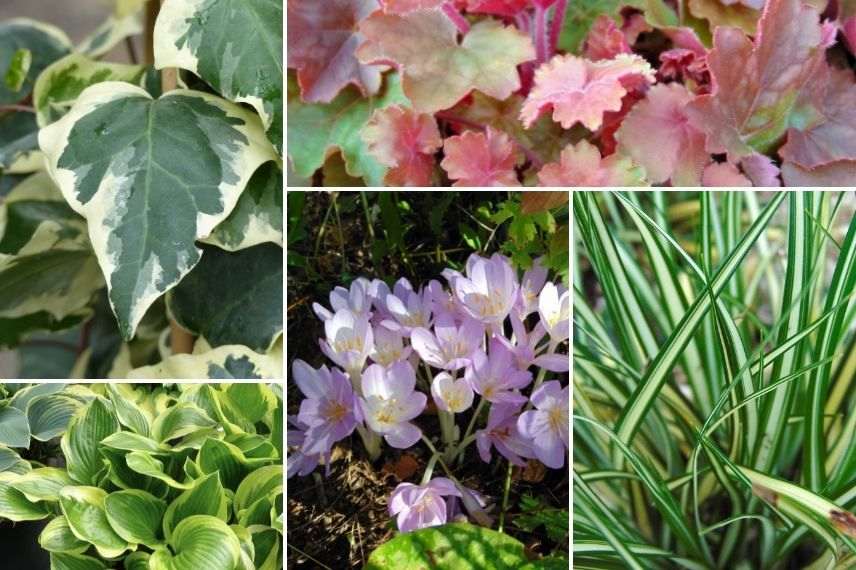
Hedera helix ‘Marginata Elegantissima’, Heuchera ‘Cherry Cola’, Hosta ‘Queen Josephine’, Colchicum autumnale and Carex oshimensis ‘Evergold’
For a lovely cool rockery
Colchicums can also be planted in a cool rockery (where the soil does not dry out too much in summer), among other small bulb plants, with a creeping, cushion-like habit, or slightly larger ones to create height variations.
Spring crocuses, hyacinths or daffodils will precede the flowering of our colchicums. The hardy geraniums will also prove to be excellent companions for our colchicums.
The Cilician colchicum is perfectly suited for rockery cultivation, as it enjoys sunny spots and well-drained, even calcareous, soils. With it, plant some pink ash geraniums (Geranium cinereum ‘Ballerina’, ‘Jolly Jewel Night’ or ‘Carol’) for a beautiful harmony of colours.
Creeping bugle (Ajuga reptans ‘Purple Torch’ or ‘Gold Chang’) and saxifrages (Saxifraga cortusifolia ‘Cheap Confections’, ‘Black Ruby’ or Saxifraga fortunei ‘Sugar Plum Fairy’) will also be perfect companions in a rockery that is a bit more shaded.
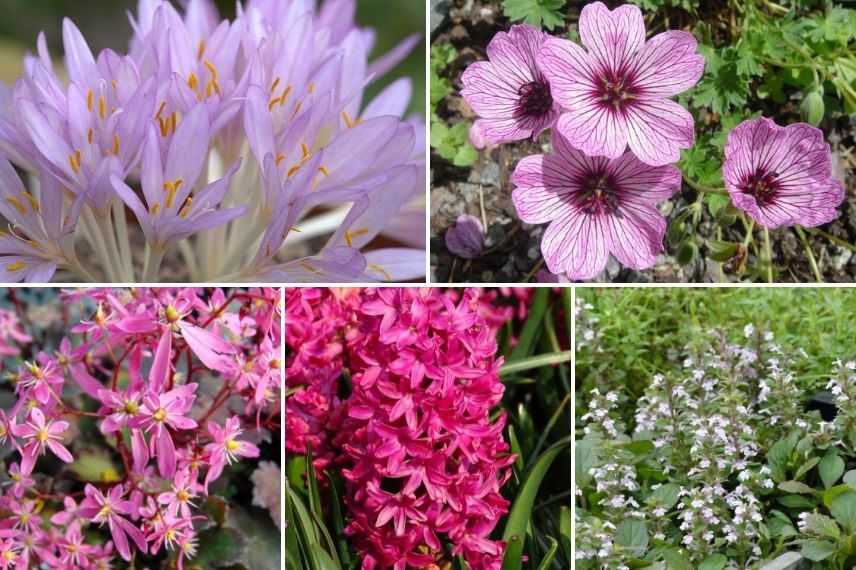
Colchicum cilicicum (photo Averater – Wikimedia), Geranium cinereum ‘Ballerina’ (photo Wikipedia), Saxifraga cortusifolia ‘Black Ruby’, Hyacinth ‘Jan Bos’ and Ajuga ‘Purple Torch’
To add colour to light woodland areas
Colchicums are excellent candidates for light woodlands, in areas with sparse exposure allowing light to filter through, such as at the base of deciduous trees.
Together with ferns, they will add colour while maintaining a very natural style.
Also accompany colchicums with lovely little violets flowering until November (Viola tricolor, Viola ‘Brush Strokes’) or periwinkles groundcovers, which bloom again in autumn (Vinca minor ‘Flower Power’, Vinca minor ‘Josefine’). Their blue-mauve colour will perfectly complement a successful palette with colchicum hybrid ‘The Giant’, colchicum speciosum ‘Atrorubens’ or even colchicum of Cilicia.
Beautiful tricyrtis or orchid lily and cyclamen from Naples will wonderfully complete this woodland decor.
To add a graphic and light touch, consider ophiopogons or “beard of the serpent”, whose light evergreen foliage in mild climates resembles that of grasses.
And to take over at the end of winter, crocus tommasinianus, which tolerate light shade, will be the perfect candidates.
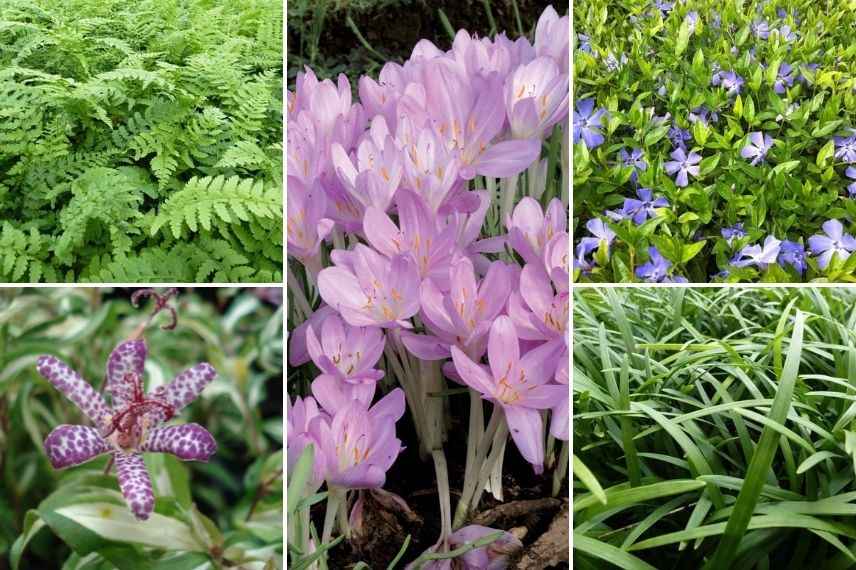
Polystichum setiferum ‘Dahlem’ (photo Guido), Colchicum ‘The Giant’, Tricyrtis ‘Imperial Banner’, Vinca minor ‘Josefine’ (photo Guido) and Ophiopogon planiscapus (photo Guido)
- Subscribe!
- Contents
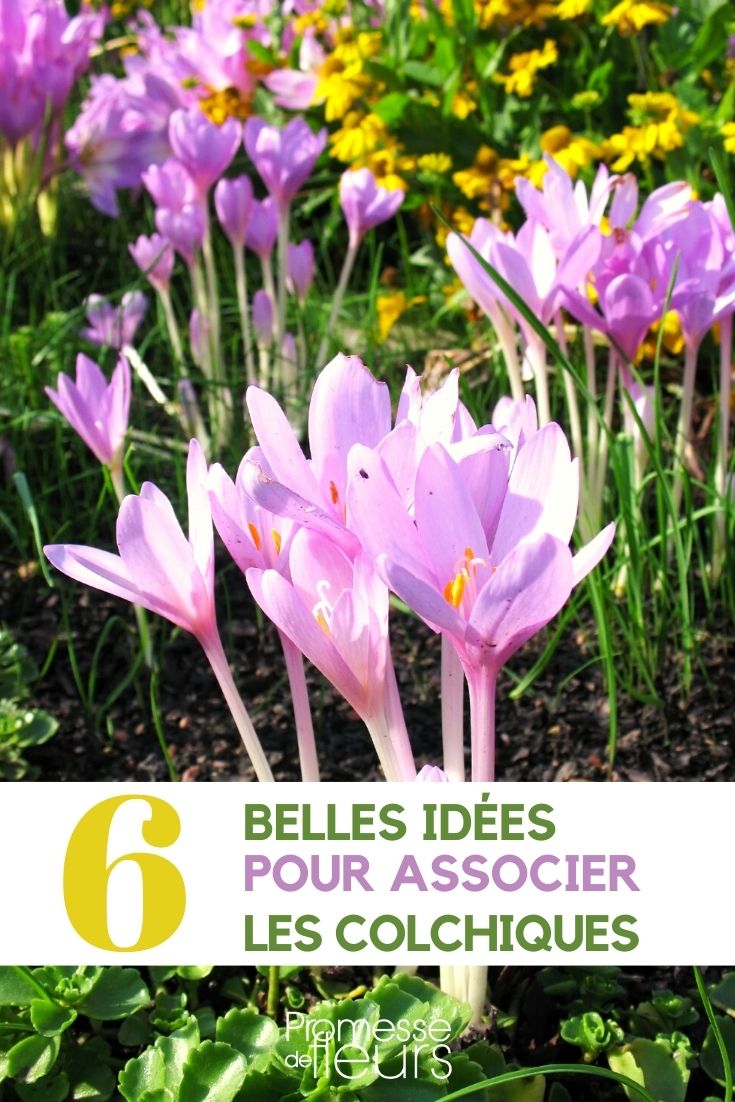































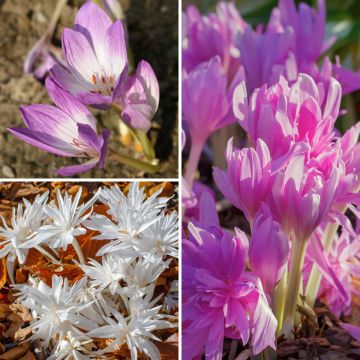
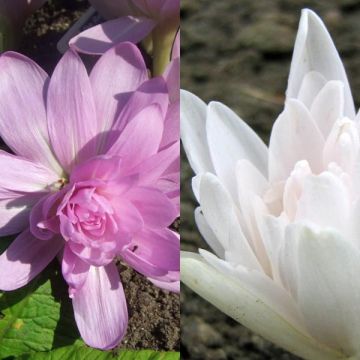

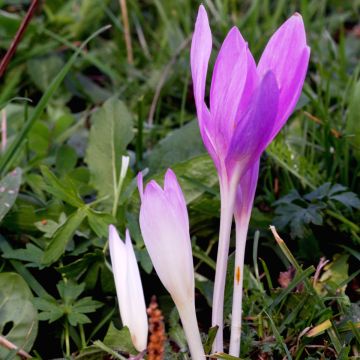
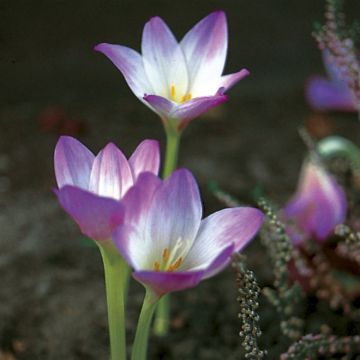
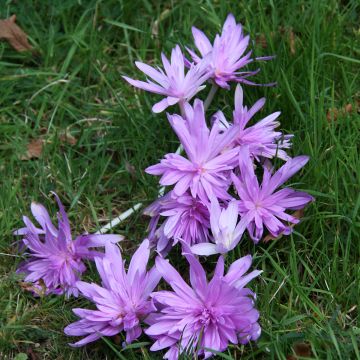
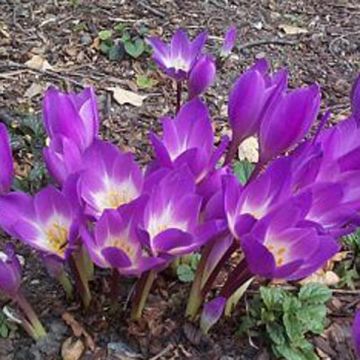

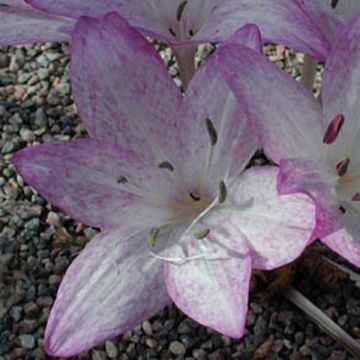
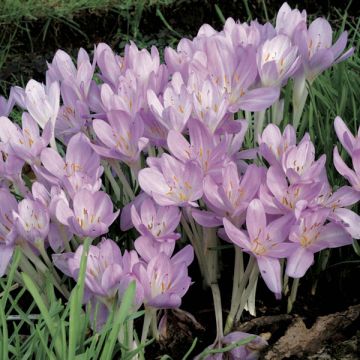
Comments